







 |
|
 |
 |
The crew at Nash’s manages about 450 acres on 10 different fields. About 75 acres are devoted to 75 varieties of mixed row crop fruits and vegetables, including about 18 acres of carrots which are harvested from July through February. Additionally, we grow kale, beet, cauliflower, and other vegetable seed crops on about 15 acres.
Grains, including red and white wheat, barley, triticale, oats, buckwheat and rye are planted on about 150 acres and the farm produces about 25 acres of cover rye/vetch seed annually, and 20 acres of fava beans and field peas.
Our pastured pig operation takes up another 35 acres, and infrastructure such as the mechanics’ shop, barns, housing, storage, packing shed, the compost operation and greenhouses occupy the remainder, along with wildlife habitat and fallow fields.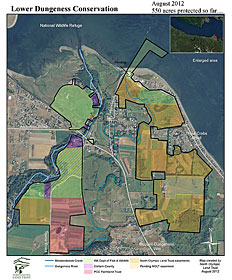
About 60% of the land that we lease has conservation easements on it and is protected from future development, which gives us confidence to continue expanding our product line and employ more people. 40% of the farm’s land base, however, is not secure, and our short term leases on these properties are challenging for long-term planning.
The Lower Dungeness Valley is a patchwork of fields under different owners, but much of it has been protected from development and dedicated to agriculture and wildlife habitat by North Olympic Land Trust, PCC Farmland Trust and the Washington State Department of Fish and Wildlife.
|
 |
 |
John Willits and the late Dr. Harry Lydiard, two visionary residents of Port Angeles, purchased the 80-acre Bell Farm in 2003 (located adjacent to lavender farm Jardin du Soleil), and leased a large portion of it to Nash's Organic Produce for agricultural purposes. Willits, an avid birder, keeps 16 acres of his eastern half in wetlands and forest for 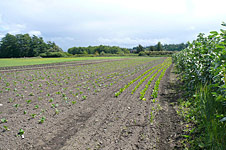 habitat. habitat.
We plant grain and hay on the rest of his portion, and some of the grain provides forage for migrating waterfowl during the winter months. The western half, owned by Lydiard's estate, is excellent, well-drained, agricultural soil with a reliable water supply, making it excellent row-crop ground. A conservation easement, held by the North Olympic Land Trust, was placed on the property in 2003, and Nash's Organic Produce has a long-term lease. These factors combined with our strong relationship with the land owners, makes this piece of land a secure one for the farm, which is important to our ability to strategically plan for the future.
|
 |
 |
Since 2003, Nash's has leased 55 acres on the west side of the Dungeness River, just south of East Anderson Road, from landowner Steve Clapp. This beautiful and fertile acreage has sandy/clay soils that drain well and are ideal for winter crops, such as carrots, parsnips and turnips.
The sandy soil, however, requires more work to maintain fertility. At our farm, fertility is not added to the soil through amendments like fertilizers. "We grow our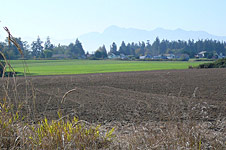 fertility," says Sam McCullough, grain and field prep manager. "We do it by cover cropping with rye and vetch, and by making high-quality compost and spreading it on the field. You can't have too much organic matter in your soil." Consequently, grain and cover crops will be planted on some part of the Clapp Field every year, because the presence of sand in the soil makes the incorporation of organic matter more challenging. fertility," says Sam McCullough, grain and field prep manager. "We do it by cover cropping with rye and vetch, and by making high-quality compost and spreading it on the field. You can't have too much organic matter in your soil." Consequently, grain and cover crops will be planted on some part of the Clapp Field every year, because the presence of sand in the soil makes the incorporation of organic matter more challenging.
West of the Clapp Field, lies a large sprawl of residential housing. Nash remembers growing carrots there 25 years ago. "It was great carrot ground, but now it's gone," he says. "I'm grateful there is still such a large piece of this good soil left."
|
 |
 |
The 80-acre Delta Farm is located on Towne Rd, across from the Dungeness Valley Creamery. It is home to some of the most fertile soil that the farm stewards, because of its close proximity to the Dungeness River. Worldwide, delta soils are typically the most fertile.
Over time, a river's course moves back and forth across a delta and heavier soil particles, such as sand and loam, drop out closest to the river. Lighter particles, like clay, drop out further away. The soils on Delta Farm are called silt loam, and are some of the richest in Washington State.
 For years, the land was a dairy farm and a cow/calf operation. Cattle create a rich microbial environment in the soil. They don't eat grasses down to the roots, like goats or sheep. They chomp off the tops of the grasses, causing part of the root system to die and become new soil. The remaining roots make the grass regrow. Meanwhile, the cows return fertility to the soil with their manure, which they kindly spread around as they walk. For years, the land was a dairy farm and a cow/calf operation. Cattle create a rich microbial environment in the soil. They don't eat grasses down to the roots, like goats or sheep. They chomp off the tops of the grasses, causing part of the root system to die and become new soil. The remaining roots make the grass regrow. Meanwhile, the cows return fertility to the soil with their manure, which they kindly spread around as they walk.
The exceptional soils of the Delta Farm were the primary reason that Nash Huber approached PCC Natural Markets, the farm's largest wholesale account, to save it from being turned into 17 residential lots in 1999. PCC sprang into action and formed the PCC Farmland Trust (PCCFLT), and the Delta Farm was its first purchase. Today the farm is protected by a conservation easement and Nash’s has a long-term lease. Since then, the PCCFLT has preserved 1,169 acres of working farmland!
Delta Farm has a farm house, a historic working barn, paddocks and pasture for livestock, the mechanics' shop, the grain dryer, and a large irrigation reservoir that holds 1 million gallons of water fed by an irrigation ditch. It is also home to the farm’s compost operation, and to about 50 acres of row crop veggies and rotations of grains and seed crops.
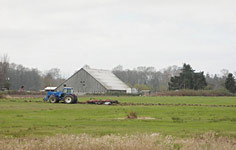 In 2012, the North Olympic Land Trust (NOLT) started negotiations with the landowners of a 10-acre parcel of prime farmland that had once been part of the Delta Farm. NOLT and Friends of the Fields had been raising funds from the community for several years for farmland protection and in April 2013, they purchased the development rights of this parcel called “24-Carrot Farm.” Shortly after, Nash and Patty Huber were able to purchase the land at affordable agricultural prices, protecting this excellent farmland from development and reuniting it with Delta Farm. In 2012, the North Olympic Land Trust (NOLT) started negotiations with the landowners of a 10-acre parcel of prime farmland that had once been part of the Delta Farm. NOLT and Friends of the Fields had been raising funds from the community for several years for farmland protection and in April 2013, they purchased the development rights of this parcel called “24-Carrot Farm.” Shortly after, Nash and Patty Huber were able to purchase the land at affordable agricultural prices, protecting this excellent farmland from development and reuniting it with Delta Farm.
|
 |
 |
The 15-acre Dungeness Farm is adjacent to the 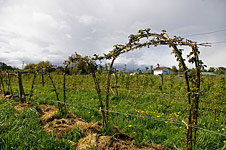 Farm Store. Nash and Patty own 9.5 of these acres, and other five do not have a conservation easement and are leased. Located just north of the Old Dungeness Schoolhouse and directly east of the Dungeness River, it’s the site of the packing shed, five greenhouses, raspberry and blackberry trellises, gooseberry bushes, and an apple and pear orchard, as well as several acres of row crops. Farm Store. Nash and Patty own 9.5 of these acres, and other five do not have a conservation easement and are leased. Located just north of the Old Dungeness Schoolhouse and directly east of the Dungeness River, it’s the site of the packing shed, five greenhouses, raspberry and blackberry trellises, gooseberry bushes, and an apple and pear orchard, as well as several acres of row crops.
 Nash actually farmed the Dungeness field for 10 years before he and Patty were in a position to buy the property in 1996. Purchasing the land and saving it from future development was extremely important to the evolution of the farm because of its central location and unique agricultural characteristics. The parcel is 9.5 acres of a soil type called Dungeness Silt Loam. The 1987 Soil Survey of Clallam County describes Dungeness Nash actually farmed the Dungeness field for 10 years before he and Patty were in a position to buy the property in 1996. Purchasing the land and saving it from future development was extremely important to the evolution of the farm because of its central location and unique agricultural characteristics. The parcel is 9.5 acres of a soil type called Dungeness Silt Loam. The 1987 Soil Survey of Clallam County describes Dungeness 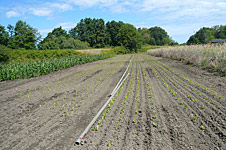 Silt Loam as prime farmland occurring along river terraces, particularly the Dungeness River. Soils meeting all of the requirements for prime farmland occupy only 1.8 percent of Clallam County. Silt Loam as prime farmland occurring along river terraces, particularly the Dungeness River. Soils meeting all of the requirements for prime farmland occupy only 1.8 percent of Clallam County.
Owning almost 10 acres of some of the best farmland in Washington State was a game-changer for Nash Huber. He capitalized on it by constructing the packing shed, which became 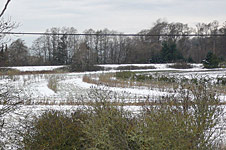 home to a large walk-in cooler (rescued from an old Safeway that was being torn down in Port Angeles), a processing line, market storage, and the sales desk. From that point forward, stores and produce distributors in Seattle, as well as local landowners with farmland to lease, looked at Nash’s Organic Produce as a bona fide business, as opposed to just a series of rented properties cultivated by a talented farmer without a home base. home to a large walk-in cooler (rescued from an old Safeway that was being torn down in Port Angeles), a processing line, market storage, and the sales desk. From that point forward, stores and produce distributors in Seattle, as well as local landowners with farmland to lease, looked at Nash’s Organic Produce as a bona fide business, as opposed to just a series of rented properties cultivated by a talented farmer without a home base.
|
 |
 |
Nash Huber farmed three acres of the old Pettit Farm for many years. When he bought his first big tractor, an International Harvester 856, the owners leased the rest to him, including a large barn. They had grazed cattle on it, so it was in good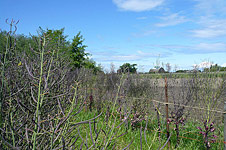 condition, since cattle grazing, if done in moderation, can be good for soil. The land is close to the Strait of Juan de Fuca, and has a high mineral content. condition, since cattle grazing, if done in moderation, can be good for soil. The land is close to the Strait of Juan de Fuca, and has a high mineral content.
Nash remembers growing high quality carrots there and getting a great yield in the early-to-mid 1990s. These were the carrots that first attracted the attention of PCC Natural Markets.
It was the daughter of John Willits, the late Kris Fairbanks, and her husband Brian, who purchased the Pettit Farm and renamed it Meadowbrook Farm in 2005. They put a conservation easement on it through the North Olympic Land Trust, and offered the farm a long-term lease.
Today, Pettit is home to row crops, grains, garlic and seed crops.
|
 |
 |
The 60-acre Wheeler Field, named for the late Don Wheeler, a local seed and grain farmer, was a turf and seed farm for about 25 years. In 2004, the owners leased it to Nash, who took it on reluctantly because of the damage done to the soil by turf 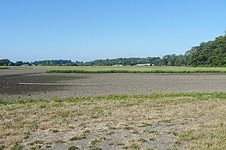 farming. However, due to the field’s proximity to the Dungeness River, its soils are slowly regained their fertility and after several years of composting and cover crops, Wheeler was certified organic. Since then we have continued to work hard to increase the health of the soil and although it has come a long way, it remains one of our weaker fields in this regard. farming. However, due to the field’s proximity to the Dungeness River, its soils are slowly regained their fertility and after several years of composting and cover crops, Wheeler was certified organic. Since then we have continued to work hard to increase the health of the soil and although it has come a long way, it remains one of our weaker fields in this regard.
The Wheeler Farm has been home to large chard and beet seed crops that we have grown for Alf Christensen Seed Co, and to grain and vegetable rotations. This year we are giving Wheeler a break from row crops. In fall 2012, Sam planted almost the whole field in two varieties of fava beans—Windsor (a larger bean for eating) and Diane (a smaller bean for cover cropping). We continue to experiment with fava production, harvesting and cleaning, so that we can develop a consumer market for dried beans, and build up a seed stock for our own and other farmers’ cover-cropping needs.
In 2007-2008, Washington State University conducted grain trials on the Wheeler Field. The property has never been short-platted, but is currently unprotected from development.
|
 |
 |
The Willits Field is named for John Willits, former forestry professor at Peninsula College, co-founder of the North Olympic Land Trust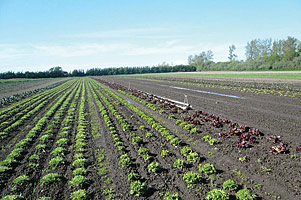 and avid birder and environmentalist. John and his wife Pat purchased 40 acres of wetland habitat in Dungeness in 1986 that they named the Quacker Farm. They also bought 40 acres immediately to the west of it (five acres at a time) in 1998-99, to prevent residential encroachment on the Quacker Farm. and avid birder and environmentalist. John and his wife Pat purchased 40 acres of wetland habitat in Dungeness in 1986 that they named the Quacker Farm. They also bought 40 acres immediately to the west of it (five acres at a time) in 1998-99, to prevent residential encroachment on the Quacker Farm.
John partnered with Nash Huber to farm 40 acres organically with a combination of row crops and grains. He wanted the grains, especially barley, to serve as food for migrating waterfowl in the winter. John also planted 35,000 cottonwood, Hooker willow and Leland cypress trees, by himself, to completely surround the farms.
The western portion of the field is wetland and has been left as habitat. The rest is excellent sandy loam farmland and row crops, grain and cover crops are planted there every year. A few acres of hay are planted in between the two sections, because hay can take more moisture. Nash’s Organic Produce has a long-term lease on the property.
Willits' ultimate vision is to create a series of wetlands and organic farms to serve as a wildlife corridor and winter refuge for migrating waterfowl. Starting at the mouth of the Dungeness River and eventually stretching as far as Graysmarsh Farm, John hopes to save over 440 acres. This ambitious conservation project is call the Lower Dungeness Basin Wetland Protection Project and involves many individual landowners, diverse government agencies, and nonprofits. Permanent protection of the corridor will be achieved through conservation easements.
This partnership is an excellent example of how organic farming can work with the environment. We thank John Willits for his vision and hard work to achieve the completion of the corridor. If you would like to support the project, contact the North Olympic Land Trust which holds the conservation easement on the Willits’ fields.
John Willits and the Willits Farm were named “Wildlife Farm of the Year” by the Washington Association of Conservation Districts and the Washington Department of Wildlife in 1999.
|
 |
 |
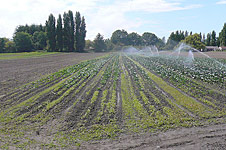 Nash started farming the 25 acres of the Wilson Field in 2000.The soils are all prime (Puget and Dungeness Silty Loam) and the field has good water sources. It grows row crops and grain equally well, and our current strawberry patch is in the northern section of the field. Nash started farming the 25 acres of the Wilson Field in 2000.The soils are all prime (Puget and Dungeness Silty Loam) and the field has good water sources. It grows row crops and grain equally well, and our current strawberry patch is in the northern section of the field.
In 2004 there was an effort to protect the field by the nonprofit Friends of the Fields (now merged with the North Olympic Land Trust but despite the fact that the project was ranked number one that year by the Washington State Recreation and Conservation Office Farmland Preservation Grants that effort eventually failed. Unfortunately, this prime, ideally situated piece of farmland currently remains open to development. You can view the Wilson Field on your way to the Farm Store, as you drive North on Sequim-Dungeness Way from downtown. It is on the north side of the road, just before you turn right to go to the store.
|
 |
 |
Located near Sunland, on the north side of 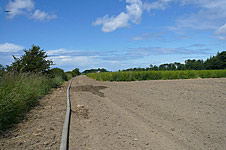 Woodcock Road, the Woodcock, or McInnes, Field is unique among the fields at Nash’s in that it has more clay content. The area most likely lay beneath a lake at one time, where fine particles settled out forming a clay layer. The soil still produces excellent vegetables, grain, and seed crops, but it requires a little more work and attention. Woodcock Road, the Woodcock, or McInnes, Field is unique among the fields at Nash’s in that it has more clay content. The area most likely lay beneath a lake at one time, where fine particles settled out forming a clay layer. The soil still produces excellent vegetables, grain, and seed crops, but it requires a little more work and attention.
The Woodcock Field is about 20 acres. At present, it is not protected by a conservation easement.
|
|





